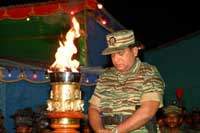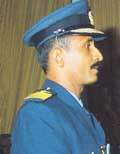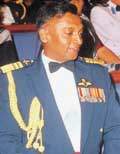 |
|||||||
|
Peace in July but no let up in security measures Tiger guerrilla leader, Velupillai Prabhakaran, appeared in public again last Friday, to pay homage to his organisation's suicide cadres.
It was on July
5, 1987, that "Captain Miller," the first suicide cadre,
drove an explosive laden truck and exploded it at Nelliady Central
College where troops were billeted. The incident left 19 soldiers
dead and 22 wounded. Troops there
were part of a group engaged in a consolidation process after the
Vadamaratchchi sector of the Jaffna peninsula was captured during
"Operation Liberation," launched on May 26, 1987. The
first phase concluded on June 1, 1987. This operation was a precursor
to the infamous Indian food drop. On Friday,
Mr. Prabhakaran took part in ceremonies in the Mullaitivu area where
he garlanded the portraits of leading suicide cadres or Black Tigers
- cadres tasked to carry out special missions of attacks or assassinations.
Parents and next of kin of those killed took part in the ceremonies.
Until December, last year, when guns fell silent in the battle areas
of the North and East, 239 suicide cadres have been killed - 175
males and 104 females. This is from a total of 17,763 Tiger guerrillas
killed in the 19 year long separatist war. Black Tiger
commemoration ceremonies were held in Jaffna, in the Wanni and in
the East. Besides religious ceremonies, the LTTE had made elaborate
plans to screen video films about Tiger attacks on military installations
- a move to seize the opportunity to recruit more cadres. Reports
from the North and East spoke about large turnouts to view the video
films. In marked contrast
to the month of July in the previous years, dubbed "Black July,"
LTTE ceremonies to pay tribute to their Black Tiger cadres this
year has been under peaceful circumstances due to the ongoing Ceasefire
Agreement. Otherwise, it is a month in which the defence establishment
in Colombo places security installations countrywide on full alert.
In the City in particular, security is stepped up to prevent suicide
attacks on VIPs or important installations. VVIPS and VIPS themselves
have cancelled many an official engagement during this month due
to intelligence warnings of attacks. Most of the
facts contained in the Special Branch report of June 5, 2002, are
correct. The passing out parade was video filmed and released to
both local and foreign television networks. They received wide play.
The first anniversary of the death of "Colonel Nizam"
is in fact further confirmation of what went on at the Army's Safe
House at Athurugiriya. It was one of the Long Range Reconnaisance
Patrols (LRRPs) operated by the Army's Directorate of Military Intelligence
(DMI) that penetrated deep into guerrilla held territory in the
East to assassinate "Colonel Nizam." Now the LTTE was
commemorating his first death anniversary whilst in the South canards
were propagated that DMI's deep penetration activities were non-existent. However, the
Directorate of Internal Intelligence (DII), the nation's premier
intelligence arm, as well as other State agencies have refuted the
Special Branch forecast of a major attack to "take complete
control" of Batticaloa area after December, this year. Whilst
recruitment and training is going on in the East, they insist there
are no such plans at present. If "Black
July," this year was tension free, there certainly was concern
in the security establishment over another significant matter -
that is the huge concession the LTTE had won through the Ceasefire
Agreement in getting the security forces to withdraw from some important
positions in the North and East. These were positions where troop
deployments were made solely on the basis of threat perceptions
during Eelam War Three. As at present, troops have been shifted to the closest camp that is not moved or shut down. This is until arrangements are made to establish either permanent or temporary camps. In other words, a greater vacuum has been created in several areas though a real threat factor does not exist since provisions of the Ceasefire Agreement are continuing to remain in force. In the Jaffna
district, the Army is occupying two schools -Sitty Vinayagar Primary
School, Palaly and a single building in Hartley College, Point Pedro,
said to adjoin the chalet of a senior Army officer. The Army has
vacated 48 schools in the district and moved troops to camps closest
to them. Re-location will only take place after construction material
to put up new structures arrive by sea in Jaffna. In the Vavuniya
district, troops continue to occupy two schools whilst seven have
been vacated. In Mannar, however, the Holy Family Convent is still
under occupation. In the Trincomalee
district, troops continue to occupy two schools whilst three have
been vacated. In the Batticaloa district three schools have been
vacated. A fourth school - Komathurai Vinayagar Vidyalaya - has
been vacated after the perimeter area of the camp has been adjusted
to exclude the school. In this regard,
August 9 this year, marks a significant date in the peace calendar.
The time frames set out in the February 22 Ceasefire Agreement for
the execution of various activities end on this date. The very last
time frame - August 9 - is the deadline by which the security forces
are required to vacate all school buildings they occupy. In accordance
with the Agreement, troops have already withdrawn from the majority
of the places of worship from March 24. With the completion of all deadlines listed in the Ceasefire Agreement on August 9, both the Government and the Tiger guerrillas will make their own assessments of how all provisions have been enforced. That is not all. Residual issues raised by the LTTE, like passage in the north eastern seas, carrying weapons, would have to be resolved before the scheduled talks in Thailand. Whether that could happen in August still remains speculative. Veteran transport
pilot is new
Air Force Chief
His official
car collided with a lorry at Horton Place-Castle Street junction
seriously injuring the lorry assistant. He died on Friday morning.
A lady Air Force officer, who was found in the company of Air Marshal
Weerakkody at the time of the incident, was also slightly injured.
An Air Force driver turned up at the Borella Police station to own
up that he was the driver but Air Marshal Weerakkody was to later
assert he had no knowledge of how that happened. He said he was
the driver. After calls
on President Chandrika Bandaranaike Kumaratunga and Prime Minister
Ranil Wickremesinghe, Air Marshal Weerakkody handed in his retirement
papers to Defence Secretary Austin Fernando, on Friday evening.
He has sought to retire from the post of Air Force Commander after
a week'stime. This is to enable Air Marshal Weerakkody to pay farewell
calls to main SLAF installations countrywide. Air Vice Marshal
Donald Perera, who is to be promoted to the rank of Air Marshal
next week, is a veteran transport pilot who has flown fixed wing
aircraft. He has qualified to fly almost all aircraft in the SLAF
inventory including Avro, Convair, Y-8, Y 12 and Beechking aircraft.
In 1984, when
he was flying a Cessna 337 aircraft, it developed technical problems.
Described as a methodical man, he carefully went through procedure
after procedure to make a perfect belly landing that caused little
damage to the aircraft. Unlike senior
officers who would use other ranks to "water shine" their
boots, Air Vice Marshal Perera, is known to do it himself. His neighbours
speak of his simplicity and how he polished his own boots, bare-bodied
and wearing only a pair of shorts. Last December,
some leading businessmen telephoned him for appointments to meet
him at his residence. They were to bring him the customary New Year
hamper. "Your wishing me on the telephone is good enough. You
don't have to come here. Thank you very much", he told one
of them. A product of
India's National Defence College, AVM Perera also attended a staff
course in the United States. He has served in several key positions
including that of Director, Operations and Base Commander at the
SLAF bases in Katunayake and China Bay. He belongs to the same batch
as Air Marshal Weerakkody, joining the SLAF in 1971 and being commissioned
as an officer in 1972. His is the son of a pilot cum engineer in
the one time national carrier Air Ceylon. His wife Wing Commander Ranjini Piyasena is attached to the Dental Wing of the SLAF. She is currently assigned to the Kotelawala Defence Academy. |
|||||||
|
Situation Report Archives
Copyright © 2001 Wijeya Newspapers
Ltd. All rights reserved. |
|||||||


